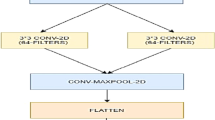Abstract
Melanoma, a malignant skin lesion, is the deadliest of all types of skin cancer. Deep learning has been shown to efficiently identify patterns from images and signals from various application domains. Use of deep learning in medical image analysis is, however, limited till date. In the present paper, two well-known malignant lesion image datasets, namely Dermofit and MEDNODE, are both separately and together used to analyze the performance of a proposed deep convolutional neural network (CNN) named as CNN malignant lesion detection (CMLD) architecture. When Dermofit and MEDNODE datasets are used separately with tenfold data augmentation, the CNN gives 90.58 and 90.14% classification accuracy. When the datasets are mixed together the CMLD gives only 83.07% accuracy. The classification accuracy of the MEDNODE dataset using deep CNN is considerably high in comparison with the results found in the related literature. The classification accuracy is also high in case of Dermofit dataset in comparison with the traditional feature-based classification.
Access this chapter
Tax calculation will be finalised at checkout
Purchases are for personal use only
Similar content being viewed by others
References
Corrie P, Hategan M, Fife K, Parkinson C (2014) Management of melanoma. Br Med Bull 111(1):149–162. https://doi.org/10.1093/bmb/ldu019
Riker AI, Zea N, Trinh T (2010) The epidemiology, prevention, and detection of melanoma. Ochsner J 10(2):56–65
Marks R (2000) Epidemiology of melanoma. Clin Exp Dermatol 25:459–463. https://doi.org/10.1046/j.1365-2230.2000.00693.x
Tan TY, Zhang L, Jiang M (2016) An intelligent decision support system for skin cancer detection from dermoscopic images. In: 12th International conference on natural computation, fuzzy systems and knowledge discovery (ICNC-FSKD), pp 2194–2199
Mukherjee S, Adhikari A, Roy M (2018) Malignant melanoma identification using best visually imperceptible features from Dermofit dataset. Accepted and presented in 1st international conference on emerging trends in engineering and science (ETES-2018)
Ballerini L, Fisher RB, Aldridge RB, Rees J (2013) A color and texture based hierarchical K-NN approach to the classification of non-melanoma skin lesions, color medical image analysis. In: Celebi ME, Schaefer G (eds) Lecture notes in computational vision and biomechanics, vol 6, pp 63–86
Laskaris N, Ballerini L, Fisher RB, Aldridge B, Rees J (2010) Fuzzy description of skin lesions. In: SPIE conference proceedings, vol 7627. https://doi.org/10.1117/12.845294
Giotis I, Molders N, Land S, Biehl M, Jonkman MF, Petkov N (2015) MED-NODE: a computer-assisted melanoma diagnosis system using non-dermoscopic images. Expert Syst Appl 42:6578–6585
Mukherjee S, Adhikari A, Roy M Malignant melanoma detection using multi layer perceptron with visually imperceptible features and PCA components from MED-NODE dataset. Int J Med Eng Inf Inderscience (UK) Enterprise Ltd. Publishers (in press)
Mukherjee S, Adhikari A, Roy M (2018) Melanoma identification using MLP with parameter selected by metaheuristic algorithms, intelligent innovations in multimedia data engineering and management. Published from IGI Global, pp 241–268. ISBN 9781522571070
Nasr-Esfahani E, Samavi S, Karimi N, Soroushmehr SMR, Jafari MH, Ward K, Najarian K (2016) Melanoma detection by analysis of clinical images using convolutional neural network. In: 38th Annual international conference of the IEEE engineering in medicine and biology society (EMBC), pp 1373–1376
Pomponiu V, Nejati H, Cheung NM (2016) DEEPMOLE: deep neural networks for skin mole lesion classification. IEEE ICIP, pp 2623–2627
Ayan E, Unver HM (2018) Data augmentation importance for classification of skin lesions via deep learning. In: Electric electronics, computer science, biomedical engineerings’ meeting (EBBT), Istanbul, pp 1–4
Kwasigroch A, Mikolajczyk A, Grochowski M (2017) Deep neural networks approach to skin lesions classification—a comparative analysis. In: 2017 IEEE conference, pp 1069–1074
Maia LB, Lima A, Pereira RMP (2017) Evaluation of melanoma diagnosis using deep features. In: 2017 IEEE conference, pp 1069–1074
Lopez AR, Giro-i-Nieto X, Burdick J, Marques O (2017) Skin lesion classification from dermoscopic images using deep learning techniques. In: Proceedings of the lASTED international conference biomedical engineering (BioMed 2017), Innsbruck, Austria, pp 49–54
Ali AA, Al-Marzouqi H (2017) Melanoma detection using regular convolutional neural networks. In: 2017 International conference on electrical and computing technologies and applications (ICECTA). IEEE, pp 1–5
Voulodimos A, Doulamis N, Doulamis A, Protopapadakis E (2018) Deep learning for computer vision: a brief review. Hindawi Comput Intell Neurosci 2018(Article ID 7068349):13. https://doi.org/10.1155/2018/7068349
Pak M, Kim S (2017) A review of deep learning in image recognition. In: 4th International conference on computer applications and information processing technology (CAIPT), Kuta Bali, pp 1–3
Patterson J, Gibson A (2017) Deep learning: a practitioner’s approach, 1st edn. O’Reilly, p 507
Buduma N (2017) Fundamentals of deep learning, 1st edn. O’Reilly, p 283
Hasanpour SH, Rouhani M, Fayyaz M, Sabokrou M (2016) Let’s keep it simple, using simple architectures to outperform deeper and more complex architectures. arXiv:1608.06037
Yu Z, Jiang X, Zhou F, Qin J, Ni D (2018) Melanoma recognition in dermoscopy image via aggregated deep convolutional features. IEEE Trans Biomed Eng. https://doi.org/10.1109/tbme.2018.2866166
Author information
Authors and Affiliations
Corresponding author
Editor information
Editors and Affiliations
Rights and permissions
Copyright information
© 2019 Springer Nature Singapore Pte Ltd.
About this paper
Cite this paper
Mukherjee, S., Adhikari, A., Roy, M. (2019). Malignant Melanoma Classification Using Cross-Platform Dataset with Deep Learning CNN Architecture. In: Bhattacharyya, S., Pal, S., Pan, I., Das, A. (eds) Recent Trends in Signal and Image Processing. Advances in Intelligent Systems and Computing, vol 922. Springer, Singapore. https://doi.org/10.1007/978-981-13-6783-0_4
Download citation
DOI: https://doi.org/10.1007/978-981-13-6783-0_4
Published:
Publisher Name: Springer, Singapore
Print ISBN: 978-981-13-6782-3
Online ISBN: 978-981-13-6783-0
eBook Packages: EngineeringEngineering (R0)




